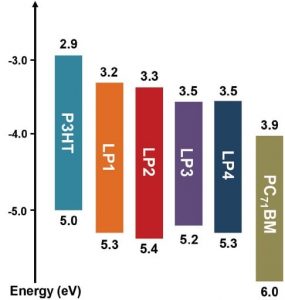Given the promise of relatively low-cost, lightweight, flexible, organic photovoltaics, it is important to meet the challenges toward improving their performance. The materia ls used in their manufacture typically suffer from narrow absorption bands and losses due to thermalisation, creating a trade-off between the photocurrent and photovoltage.
ls used in their manufacture typically suffer from narrow absorption bands and losses due to thermalisation, creating a trade-off between the photocurrent and photovoltage.
A strategy to broaden the absorption range of polymer solar cells is demonstrated by researchers from China, who use donor polymers (LP) with complementary absorption ranges to create a ladder-like structure of bandgaps within their material.
 The result, a ternary polymer blend bulk-heterojunction solar cell, displays an enhanced light-harvesting ability and morphological control without the need for careful or precise processing conditions. This is possible due to the amorphous nature of the polymers chosen for the blend, which means that the morphology of the ternary system is insensitive to the blending ratio, and it leaves the electronic properties unchanged while boosting the photocurrent.
The result, a ternary polymer blend bulk-heterojunction solar cell, displays an enhanced light-harvesting ability and morphological control without the need for careful or precise processing conditions. This is possible due to the amorphous nature of the polymers chosen for the blend, which means that the morphology of the ternary system is insensitive to the blending ratio, and it leaves the electronic properties unchanged while boosting the photocurrent.
The systems realised via this simple absorption-broadening method display a maximum power-conversion efficiency of an impressive 8.09%, indicating the potential for this method as a successful strategy to improve the performance of polymer solar cells.














